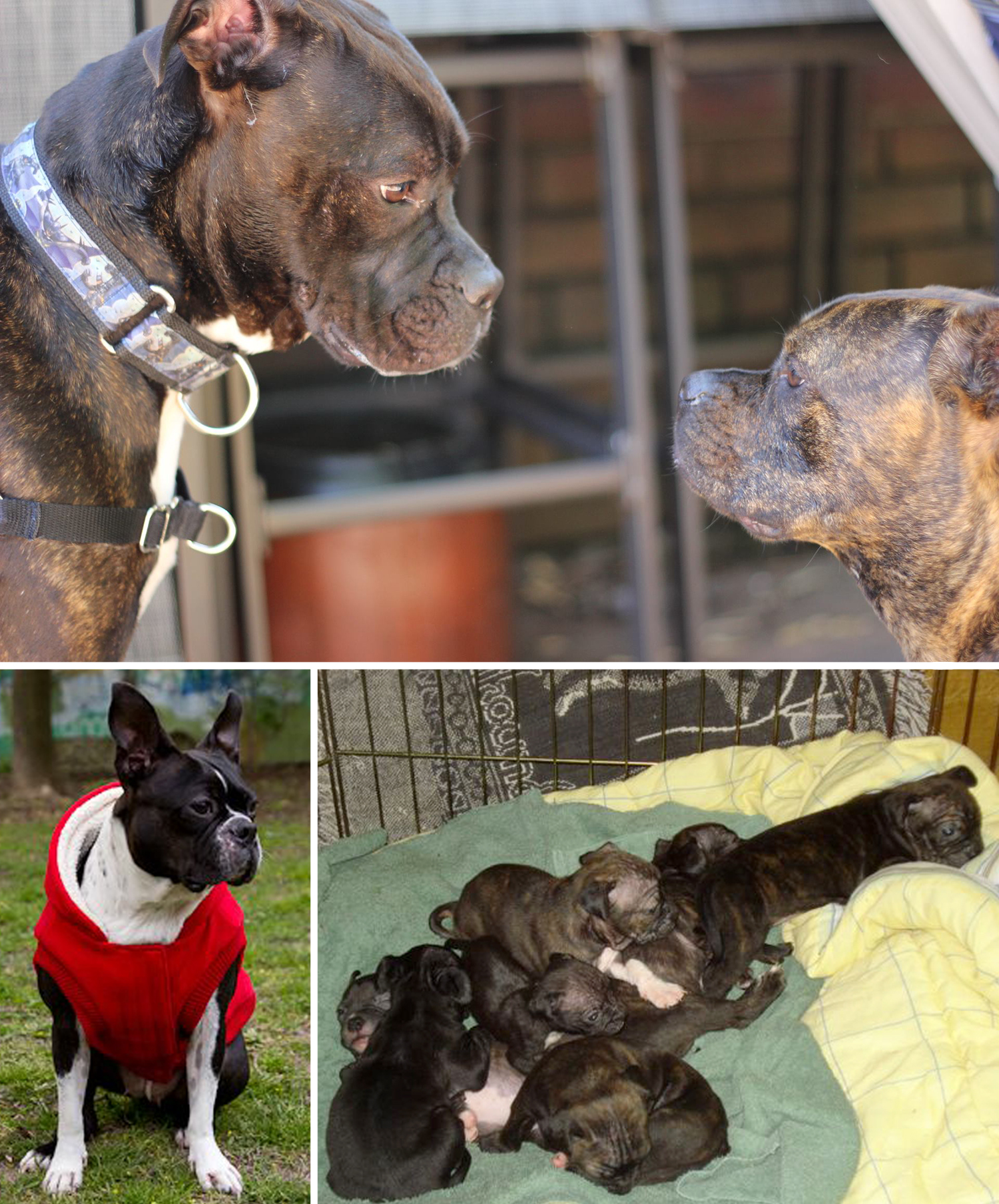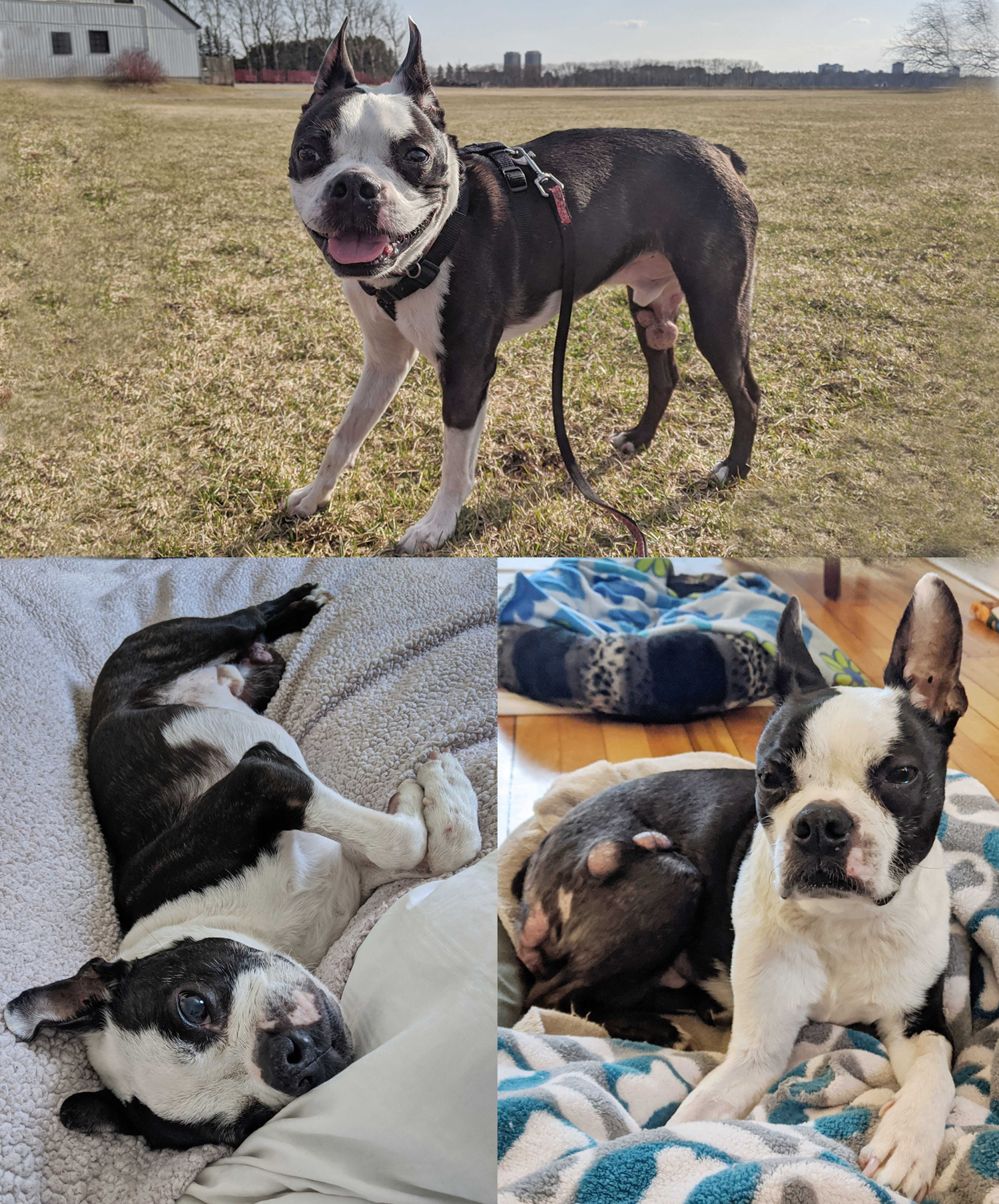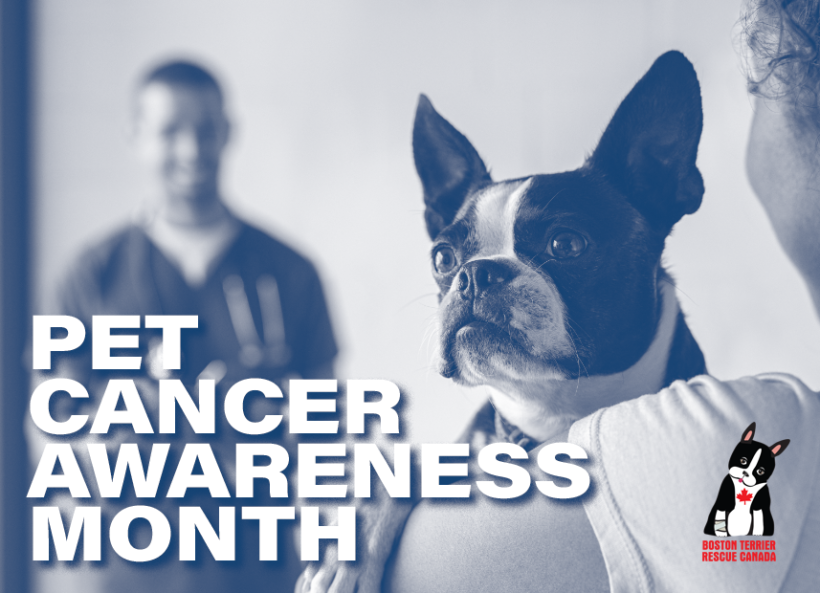Boston Terrier Rescue Canada volunteers Cathy Baillie-Whitehead (BTRC alum Swagger) and Ora Artsy and Pauli Thurner (Set for Life Trooper Georgie) share their experiences with canine cancer.
SWAGGER
Our Boston Terrier mix (and BTRC alum) Swagger has always been a lumpy guy. He has had fatty bumps and lumps removed from his shoulder and most recently his chest. The chest lump was worrisome as it seemed to grow quickly, and we began to suspect cancer. By the time his surgery was booked, the chest lump was the size of a baseball.

Before his surgery, we did a whole-body rub down to see if there were any other lumps that should be examined. We found a quarter-size bump in Swagger’s neck and mentioned it to the vet. The vet suggested a biopsy and we agreed. With every lump removal, we opted for a biopsy or surgical tissue sample as this is the only way to know what might be causing the growths.
The term biopsy can be scary for some, but it is a safe and relatively simple diagnostic tool. Lumps and bumps are typically biopsied using fine-needle aspiration (FNA). This involves taking a small needle with a syringe and suctioning a sample of cells directly from the site and placing them on a microscope slide. A veterinary pathologist then examines the slide under a microscope.
The surgery went well and both of Swagger’s lumps were removed. A few days later, we received word that the larger lump was fatty tissue, however, the smaller hard lump was a low-grade malignant (cancerous) mast cell tumour (MCT).
We didn’t realize it but MCTs are among the most common tumours found in dogs and brachycephalic breeds (flat-faced dogs) such as Boston terriers, boxers, pugs and bulldogs have a higher risk of developing mast cell tumours. Being a BT mix, Swagger fits into this higher risk category.
We were shocked but thankfully, the vet removed all the tissue around that tumour and believed that we caught it early enough that further treatment was not necessary at this time, but we will have to keep track of any lumps or bumps regardless of how tiny.
TROOPER GEORGIE
Trooper Georgie (aka TG) is one of BTRC’s “Set for Life” dogs. Approximately 6-7 years old, TG has high-grade aggressive malignant MCTs. Arriving at BTRC as a stray, TG had one complicated surgery to remove an enormous mass from his rear leg but unfortunately, several new lumps appeared shortly after and continue to grow quickly.

When we found out Trooper Georgie’s removed tumour was a high-grade MCT and several new ones were rapidly growing, we had no prior experience and had limited knowledge of what this meant. Coupled with a vet that seemed to have limited experience with MCTs, we decided to consult a veterinary oncologist. The veterinary oncology team provided us with plain language factual information about MCTs and options about how to proceed with care for TG. The oncology team took the time to answer all of our questions and continues to be available as new questions arise.
Supportive medications manage the secondary damage caused by the release of chemicals in MCTs, which can include ulcers, hives, swelling, itching and bleeding disorders. Prednisone (a steroid) acts as an “antineoplastic” to help prevent swelling and inhibit new growths. TG also takes an antihistamine (Benadryl), an antacid, and probiotics to soothe his digestive tract and support his immune system. Any mild pain is managed with Gabapentin.
While chemotherapy has a ~50% success rate in dogs, Georgie has been undergoing chemo for three months with positive results and the MCTs have not spread to other areas of his skin or internal organs. While the tumours are still present (he has three tumour groups) they have gotten noticeably and measurably smaller. We are also happy to note that he has had almost no side effects (he vomited once). While we would have liked to see a complete reduction in tumour size, we are happy that he is enjoying a good quality of life. He has a great appetite, is energetic and loves his two walks a day. If it wasn’t for the visible tumours, you would never know he has cancer.
One challenge we face is Georgie’s obsession with licking his tumours, so he does need to wear a cone when not supervised to prevent any chance of infection. Don’t worry – he has a Comfy Cone and isn’t too bothered by it. Thankfully we are working from home full-time so time in the cone is limited.
When this all started, we questioned if chemotherapy was the right choice. Would we be putting Georgie through a process that would cause him stress and discomfort? Is it worth the expense? While all dogs are different, with no side effects ultimately this has been the right decision for Georgie. Without chemo, who knows if he would still be here today. We spoil him with healthy food and treats and the occasional cheese and chips. He gets daily walks and enjoys frequent visits to green spaces and parks. He’s been to a cottage and enjoyed walks through pine forests and is generally just spoiled with lots and lots of petting and love. While we do not know how much time Georgie has, we are cherishing all the quality time we have with him.
WHAT WE LEARNED
Cancer doesn’t have to be life-threatening but keeping tabs on your dog’s health is important:
- Regular full-body examinations are key, feeling for and noting any sores or lumps. Make note of any changes to size, texture or if anything is not healing as it should.
- Learn what typical behaviour looks like for your dog. Pay attention if your dog is unusually tired, has a change in appetite, if their weight changes in a short period of time, or if there is any discharge or bleeding from any part of their body.
- MCTs are actually one of the most treatable types of cancer.
- It is important to note that MCTs can occur anywhere on the body. The biological behaviour of these tumours can vary widely; some may be present for many months without growing much, while others can appear suddenly and grow very quickly. The most common sites of MCT spread (metastasis) are the lymph nodes, spleen and liver.
- In lower-grade tumours with no evidence of spread, like Swagger’s, surgery is likely the best option. This provides the best long-term control, and chemotherapy is not typically required. In higher-grade tumours, however, even without evidence of spread, a combination of surgery and chemotherapy is often recommended.
- Should your pet need chemotherapy, side effects for dogs are usually milder and generally last for a shorter period than for humans due to the spaced-out frequency of treatment. Approximately 80 percent of dogs have no side effects at all. Though side effects are rarely seen, they can include nausea, vomiting, diarrhea, and lethargy.
- Find a vet that you trust and be sure to contact them if you have any questions or concerns.
- For medium and high-grade or reoccurring MCTs, consider consulting a veterinary oncologist to ensure a comprehensive treatment plan for your dog and the best possible quality of life.
BTRC Ana-Maria Davies Memorial Set for Life Program
The Ana-Maria Davies Memorial ‘Set for Life’ Program is a lifesaver for dogs that are considered unadoptable, primarily due to advanced age and/or medical conditions. With proper care, these dogs can still enjoy a good quality of life.
Ongoing medical costs for Set for Life dogs such as Trooper Georgie do put a strain on our resources. Chemotherapy and related expenses add up. We never want to be forced to turn a dog away, or compromise their treatment, when we are their last chance. As we round out Pet Cancer Awareness month, please consider donating to BTRC to support the ongoing care of dogs like TG.
SOURCE: SUE ETTINGER, DVM, DACVIM (ONCOLOGY)
http://vcahospitals.com/know-your-pet/mast-cell-tumors-in-dogs
https://www.vet.upenn.edu



